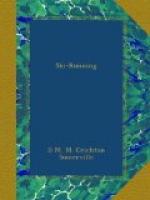A course is easily found by using an aneroid, or it may also be worked off the Ordnance Map. Any ordinary watch with a second hand will suffice for the timing of one’s own run.
Some people may think that I am a little harsh in my reasons for suggesting that beginners should not enter for the running part of the 3rd-class test so lightheartedly. It is really for their own sakes as much as for that of the judge’s. Failure is very discouraging, and I have known people’s nerve quite upset by one of these runs. They have tried to race down and have taken really nasty tosses in their rush, while the fatigue of constant falling and getting up out of deep snow, becoming more and more out of breath in the anxiety to compete, is very bad for their running. I have often wanted to hide my head in shame when coming home after such a test with a lot of worn-out people, wet through, who have failed. And yet, such is life, that many with the first breath, after they finish exhausted, will ask when the next Test takes place in order that they may compete again. Such a candidate really does one’s heart good.
Tests have probably done more than anything else to improve the standard of British running. We all have a liking for competition, and here is our chance. Having succeeded in passing the 3rd-class test, we can wear a badge and then we have to ski better in order to prove worthy of it, and presently we see no reason against qualifying for the 2nd-class test before going home. “After all, the turns only have to be done on a steeper slope.” “The run can be put off till next Winter, and passed the moment we come out,” they say.
The 1st-class standard is rising higher and higher as British Ski runners become more proficient. The runner who passed a year or two ago now hesitates to wear the gold badge, because he often realizes that his speed and turns are not good enough for what is now required.
Judges of the British Ski tests may be found in most well-known centres, but, as there are very few 1st-class people, the tests for this class are usually run in one or two districts only.
GUIDES AND SKI INSTRUCTORS
Swiss Guides are certificated by the Swiss Alpine Club and are the only people permitted by law to guide parties among the higher mountains. A tariff exists in every district showing the fees which these Guides must charge. In addition to the fee, the client usually gives a gratuity and also pays for the Guide’s accommodation and provisions on the tour. A percentage may be added for numbers greater than those provided for in the tariff, while on a really difficult tour, the Guide will probably refuse to take more than two or three runners unless a second Guide or porter be engaged. The Certificated Guides wear a badge issued by the Swiss Alpine Club and any man wearing this may be depended upon to be a good fellow, a careful Guide, and a philosopher and friend. Most of them can now ski well, though a few of the older ones may not be very proficient in technique and may be stick riders.




